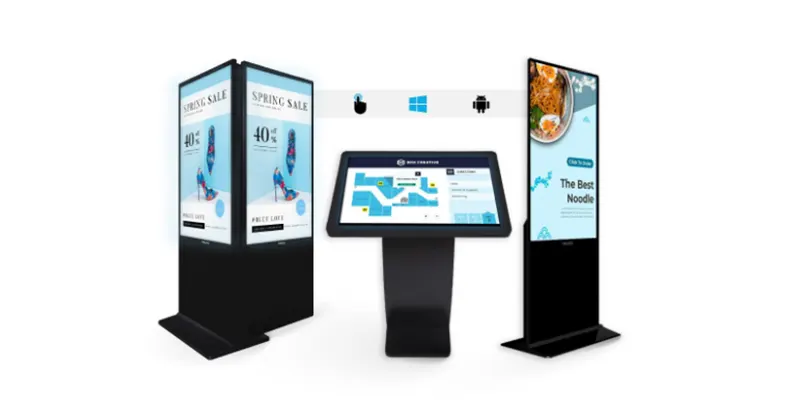What Are Interactive Digital Displays?
In today’s fast-paced digital era, static screens are no longer enough. People crave interaction — tapping, swiping, and engaging with content in real time. Interactive digital displays make that possible. They are dynamic screens that allow users to control, explore, and respond to digital content directly through touch or gestures.
Whether it’s a self-service kiosk in a shopping mall, an interactive map in a hospital, or a digital whiteboard in a classroom — these displays transform passive viewers into active participants.
Key Features of Interactive Digital Displays
1.Touchscreen Interactivity
These displays respond instantly to human touch, supporting gestures like tap, pinch, and zoom. Multi-touch capabilities allow multiple users to interact simultaneously.
2.Multi-User Engagement
Perfect for collaborative environments — classrooms, meeting rooms, and exhibitions — they let several people engage with the same screen at once.
3.Real-Time Content Updates
Content can be changed on the fly through a content management system (CMS). This ensures the information displayed is always current and relevant.
4.Integration with Cloud and IoT Systems
Cloud connectivity allows remote management, while IoT integration enables data sharing between devices — from sensors to smartphones.
Types of Interactive Digital Displays
These are self-service stations often seen in malls, airports, and hospitals. They help users access information, make purchases, or check-in with just a few taps.Ideal for classrooms and corporat
Ideal for classrooms and corporate meetings, interactive whiteboards encourage collaboration and brainstorming, allowing participants to write, draw, or share ideas digitally.
For high-impact environments like trade shows or museums, video walls and touch tables offer immersive, large-scale interaction.
Designed for durability, outdoor displays withstand weather while offering intuitive interfaces for wayfinding, promotions, or customer engagement.

Applications Across Industries
1.Education and Training
Teachers use digital whiteboards for interactive lessons, quizzes, and group activities — making learning more engaging and memorable.
2.Retail and Hospitality
Stores and restaurants use interactive displays for virtual catalogs, self-ordering, and personalized promotions, creating an immersive shopping experience.
3.Corporate and Workplace Communication
Companies deploy displays for presentations, project collaboration, and digital signage to streamline communication across teams.
4.Healthcare and Public Services
Hospitals use interactive wayfinding maps, check-in kiosks, and patient information boards to enhance the visitor experience and operational efficiency.
Benefits of Using Interactive Digital Displays
1.Enhanced Engagement and Learning
Interactive content captures attention and improves retention. Whether in a classroom or a store, engagement leads to better outcomes.
2.Brand Visibility and Customer Experience
Dynamic displays strengthen brand identity and deliver personalized experiences that traditional signs can’t match.
3.Data Collection and Insights
Each touch or interaction generates valuable data. Businesses use these insights to understand user behavior and improve services.
How Interactive Digital Displays Work
1.Hardware Components
These include LED or LCD panels, touch sensors, processors, and enclosures. The hardware determines display quality, responsiveness, and durability.
2.Software and Content Management
A powerful CMS allows administrators to control and update content remotely — from advertisements to informational screens.
3.Connectivity and User Interface Design
Wi-Fi, Bluetooth, and cloud integration ensure smooth performance. Meanwhile, UI design ensures content is intuitive and easy to navigate.
Choosing the Right Display for Your Needs
1.Screen Size and Resolution
A larger screen is ideal for group use, while compact displays suit personal or retail interactions. Always aim for high resolution to ensure clarity.
2.Environment and Usage Context
Indoor or outdoor use impacts brightness, durability, and enclosure design. Retail, education, and healthcare each require tailored solutions.
3.Budget and Maintenance Considerations
Consider not only the upfront cost but also long-term maintenance, software licenses, and energy consumption.

Conclusion
Interactive digital displays have revolutionized how we communicate, learn, and engage. They blend technology with human interaction, transforming static content into dynamic experiences. Whether in education, business, or healthcare, their ability to connect people with information in real time makes them an essential tool for the modern world.
If your organization is ready to adopt interactive digital displays, contact us today to explore customized solutions that fit your needs and budget.
FAQs
1. What is an interactive digital display?
It’s a touchscreen-based digital system that allows users to engage directly with displayed content through touch, gestures, or connected devices.
2. Where are interactive displays used?
They’re used in schools, offices, hospitals, malls, and public spaces for education, navigation, marketing, and collaboration.
3. Are interactive digital displays expensive?
Prices vary by size, technology, and functionality. However, they provide long-term value through engagement and automation.
4. What’s the difference between an interactive display and a digital signage screen?
Digital signage is mainly for one-way content delivery, while interactive displays allow two-way engagement between users and content.
5. Can interactive displays be customized?
Yes, most systems can be tailored for branding, functionality, and integration with existing digital infrastructure.
